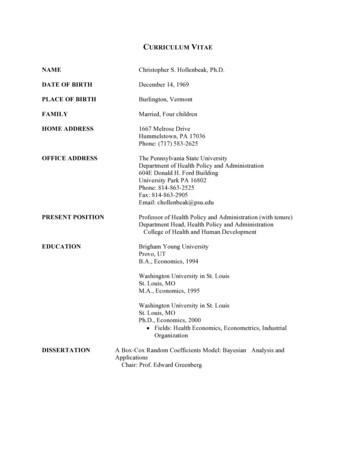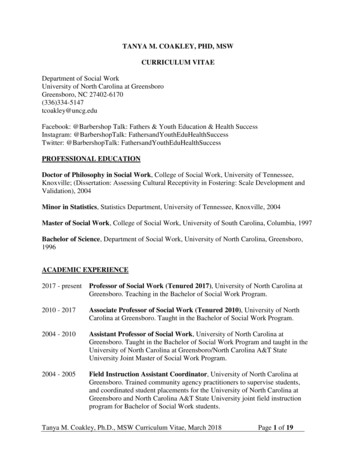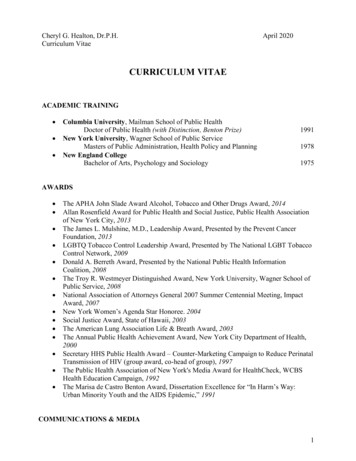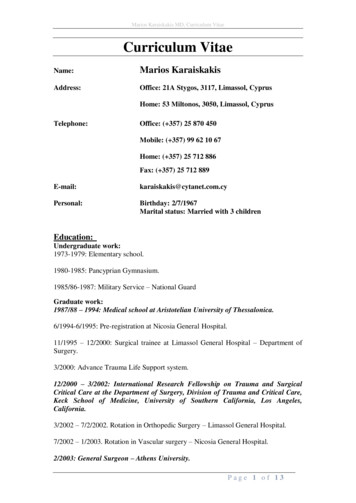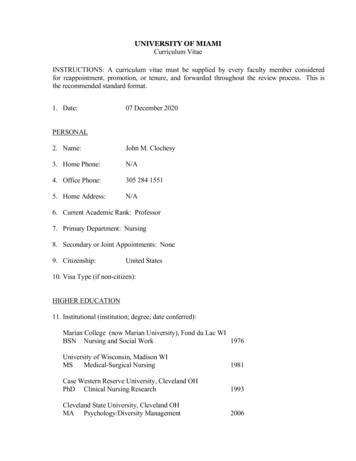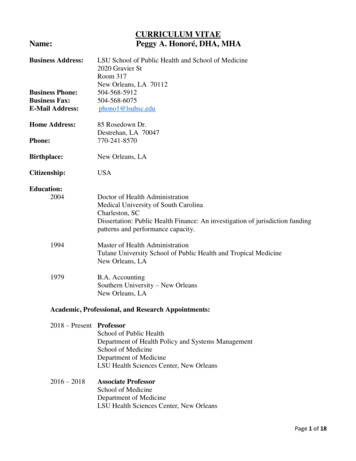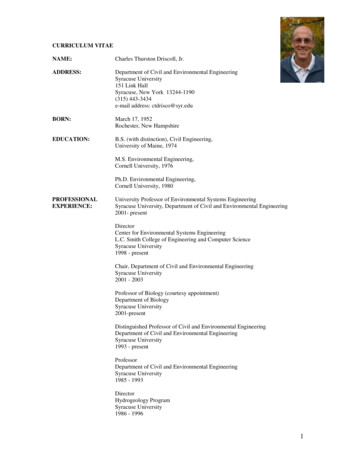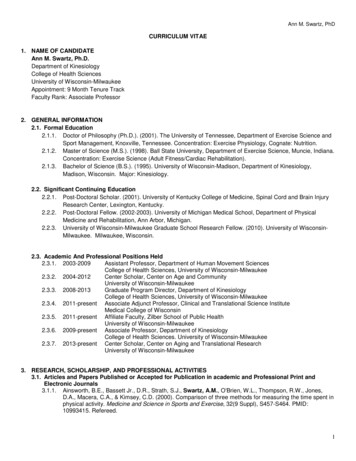
Transcription
Ann M. Swartz, PhDCURRICULUM VITAE1. NAME OF CANDIDATEAnn M. Swartz, Ph.D.Department of KinesiologyCollege of Health SciencesUniversity of Wisconsin-MilwaukeeAppointment: 9 Month Tenure TrackFaculty Rank: Associate Professor2. GENERAL INFORMATION2.1. Formal Education2.1.1. Doctor of Philosophy (Ph.D.). (2001). The University of Tennessee, Department of Exercise Science andSport Management, Knoxville, Tennessee. Concentration: Exercise Physiology, Cognate: Nutrition.2.1.2. Master of Science (M.S.). (1998). Ball State University, Department of Exercise Science, Muncie, Indiana.Concentration: Exercise Science (Adult Fitness/Cardiac Rehabilitation).2.1.3. Bachelor of Science (B.S.). (1995). University of Wisconsin-Madison, Department of Kinesiology,Madison, Wisconsin. Major: Kinesiology.2.2. Significant Continuing Education2.2.1. Post-Doctoral Scholar. (2001). University of Kentucky College of Medicine, Spinal Cord and Brain InjuryResearch Center, Lexington, Kentucky.2.2.2. Post-Doctoral Fellow. (2002-2003). University of Michigan Medical School, Department of PhysicalMedicine and Rehabilitation, Ann Arbor, Michigan.2.2.3. University of Wisconsin-Milwaukee Graduate School Research Fellow. (2010). University of WisconsinMilwaukee. Milwaukee, Wisconsin.2.3. Academic And Professional Positions Held2.3.1. 2003-2009Assistant Professor, Department of Human Movement SciencesCollege of Health Sciences, University of Wisconsin-Milwaukee2.3.2. 2004-2012Center Scholar, Center on Age and CommunityUniversity of Wisconsin-Milwaukee2.3.3. 2008-2013Graduate Program Director, Department of KinesiologyCollege of Health Sciences, University of Wisconsin-Milwaukee2.3.4. 2011-present Associate Adjunct Professor, Clinical and Translational Science InstituteMedical College of Wisconsin2.3.5. 2011-present Affiliate Faculty, Zilber School of Public HealthUniversity of Wisconsin-Milwaukee2.3.6. 2009-present Associate Professor, Department of KinesiologyCollege of Health Sciences. University of Wisconsin-Milwaukee2.3.7. 2013-present Center Scholar, Center on Aging and Translational ResearchUniversity of Wisconsin-Milwaukee3. RESEARCH, SCHOLARSHIP, AND PROFESSIONAL ACTIVITIES3.1. Articles and Papers Published or Accepted for Publication in academic and Professional Print andElectronic Journals3.1.1. Ainsworth, B.E., Bassett Jr., D.R., Strath, S.J., Swartz, A.M., O'Brien, W.L., Thompson, R.W., Jones,D.A., Macera, C.A., & Kimsey, C.D. (2000). Comparison of three methods for measuring the time spent inphysical activity. Medicine and Science in Sports and Exercise, 32(9 Suppl), S457-S464. PMID:10993415. Refereed.1
Ann M. Swartz, PhD3.1.2.Ainsworth, B.E., Haskell, W.L., Whitt, M.C., Irwin, M.L., Swartz, A.M., Strath, S.J., O'Brien, W.L., BassettJr., D.R., Schmitz, K.H., Emplaincourt, P.O., Jacobs, D.R., Jr., & Leon, A.S. (2000). Compendium ofphysical activities: an update of activity codes and MET intensities. Medicine and Science in Sports andExercise, 32(9 Suppl), S498-504. PMID: 10993420. Refereed.3.1.3.Bassett Jr., D.R., Ainsworth, B.E., Swartz, A.M., Strath, S.J., O'Brien, W.L., & King, G.A. (2000). Validityof four motion sensors in measuring moderate intensity physical activity. Medicine and Science in Sportsand Exercise, 32(9 Suppl), S471-480. PMID: 10993417. Refereed.3.1.4.Strath, S.J., Swartz, A.M., Bassett Jr., D.R., O'Brien, W.L., King, G.A., & Ainsworth, B.E. (2000).Evaluation of heart rate as a method for assessing moderate intensity physical activity. Medicine andScience in Sports and Exercise, 32(9 Suppl), S465-470. PMID: 10993416. Refereed.3.1.5.Swartz, A.M., Strath, S.J., Bassett Jr., D.R., O'Brien, W.L., King, G.A., & Ainsworth, B.E. (2000).Estimation of energy expenditure using CSA accelerometers at hip and wrist sites. Medicine and Sciencein Sports and Exercise, 32(9 Suppl), S450-456. PMID: 10993414. Refereed.3.1.6.King, G.A., Fitzhugh, E.C., Bassett Jr., D.R., McLaughlin, J.E., Strath, S.J., Swartz, A.M., & Thompson,D.L. (2001). Relationship of leisure-time physical activity and occupational activity to the prevalence ofobesity. International Journal of Obesity and Related Metabolic Disorders, 25(5), 606-612. PMID:11360141. Refereed.3.1.7.Strath, S.J., Bassett Jr., D.R., Swartz, A.M., & Thompson, D.L. (2001). Simultaneous heart rate-motionsensor technique to estimate energy expenditure. Medicine and Science in Sports and Exercise, 33(12),2118-2123. PMID: 11740308. Refereed.3.1.8.Strath, S.J., Bassett Jr., D.R., Thompson, D.L., & Swartz, A.M. (2002). Validity of the simultaneous heartrate-motion sensor technique for measuring energy expenditure. Medicine and Science in Sports andExercise, 34(5), 888-894. PMID: 11984311. Refereed.3.1.9.Swartz, A.M., Evans, M.J., King, G.A., & Thompson, D.L. (2002). Evaluation of a foot-to-foot bioelectricalimpedance analyzer in highly active, moderately active and less active young men. British Journal ofNutrition, 88(2), 205-210. PMID: 12144724. Refereed.3.1.10. Strath, S.J., Bassett Jr., D.R., Ham, S.A., & Swartz, A.M. (2003). Assessment of physical activity bytelephone interview versus objective monitoring. Medicine and Science in Sports and Exercise, 35(12),2112-2118. PMID: 14652510. Refereed.3.1.11. Strath, S.J., Bassett Jr., D.R., & Swartz, A.M. (2003). Comparison of MTI accelerometer cut-points forpredicting time spent in physical activity. International Journal of Sports Medicine, 24(4), 298-303. PMID:12784173. Refereed.3.1.12. Swartz, A.M., Bassett Jr., D.R., Moore, J.B., Thompson, D.L., & Strath, S.J. (2003). Effects of body massindex on the accuracy of an electronic pedometer. International Journal of Sports Medicine, 24(8), 588592. PMID: 14598195. Refereed.3.1.13. Swartz, A.M., Strath, S.J., Bassett Jr., D.R., Moore, J.B., Redwine, B.A., Groer, M., & Thompson, D.L.(2003). Increasing daily walking improves glucose tolerance in overweight women. Preventive Medicine,37(4), 356-362. PMID: 14507493. Refereed.3.1.14. Strath, S.J., Bassett Jr., D.R., & Swartz, A.M. (2004). Comparison of the College Alumnus QuestionnairePhysical Activity Index with objective monitoring. Annals of Epidemiology, 14(6), 409-415. PMID:15246329. Refereed.3.1.15. Tudor-Locke, C., Bassett Jr., D.R., Swartz, A.M., Strath, S.J., Parr, B.B., Reis, J.P., DuBose, K.D., &Ainsworth, B.E. (2004). A preliminary study of one year of pedometer self-monitoring. Annals ofBehavioral Medicine, 28(3), 158-162. PMID: 15576253. Refereed.2
Ann M. Swartz, PhD3.1.16. Swartz, A.M., Strath, S.J., Parker, S.J., Miller, N.E., & Cieslik, L.J. (2007). Ambulatory activity and bodymass index in white and non-white older adults. Journal of Physical Activity and Health, 4(2):294-304.PMID: 17846458. Refereed.3.1.17. Strath, S.J., Swartz, A.M., Parker, S.J., Miller, N.E., & Cieslik, L.J. (2007). Walking and metabolicsyndrome in older adults. Journal of Physical Activity and Health, 4(3):397-410. PMID: 18209231.Refereed.3.1.18. Swartz, A.M., Strath, S.J., Miller, N.E., Cashin, S.E., & Cieslik, L.J. (2007). Glucose control and walkingin a multi-ethnic sample of older adults. Gerontology, 53:454-461. PMID: 18303238. Refereed.3.1.19. Richardson, C.R., Newton, T.L., Abraham, J.J., Sen, A., Jimbo, M., & Swartz, A.M. (2008). A metaanalysis of pedometer-based walking interventions and weight loss. Annals of Family Medicine, 6:69-77.PMID: 18195317. Refereed.3.1.20. Swartz, A.M., Strath, S.J., Parker, S.J., & Miller, N.E. (2008). The impact of body mass index and stepsper day on blood pressure and fasting glucose in older adults. Journal of Aging and Physical Activity.16:188-200. Refereed.3.1.21. Strath, S.J., Holleman, R.G., Ronis, D.L., Swartz, A.M., & Richardson, C.R. (2008) Objective physicalactivity accumulation in bouts and non-bouts and relationships to markers of obesity in U.S. adults.Preventing Chronic Disease. 5(4):A131. PMID: 18793519. Refereed.3.1.22. Parker, S.J., Strath, S.J., & Swartz, A.M. (2008) Physical Activity Measurement in older adults: Impact onobservation of relationships with mental health. Journal of Aging and Physical Activity. 16: 369-380.PMID: 19033599. Refereed.3.1.23. Kang, M., Bassett Jr., D. R., Barreira, T., Tudor-Locke, C. Ainsworth, B. Reis, J.P., Strath, S.J., & Swartz,A. M. (2009). How many days are enough? A study of 365 days of pedometer monitoring. ResearchQuarterly in Exercise and Sport. 80: 1-9. PMID: 1979163. Refereed.3.1.24. Strath, S.J., Swartz, A.M., & Cashin, S.E. (2009). Ambulatory physical activity profiles of the elderly.Journal of Aging and Physical Activity. 17: 46-56. Refereed.3.1.25. Swartz, A.M., Strath, S.J., Miller, N.E., Grimm, E.K., Ewalt, L.A., Loy M.S., & Gennuso, K.P. (2009).Validity of physical activity monitors in assessing energy expenditure in normal, overweight, and obeseadults. The Open Sports Sciences Journal. 2: 58-64. PMID: 20431700. Refereed.3.1.26. Miller, N.E., Strath, S.J., Swartz, A.M., & Cashin, S.E. (2010). Estimating absolute and relative physicalactivity intensity across age via accelerometry in adults. Journal of Aging and Physical Activity. 18(2):158-170. PMID: 20440028. Refereed.3.1.27. Muehlenbein, M.P., Jordan, J., Bonner, J., & Swartz, A.M. (2010). Quantifying the usage costs of humanimmunity: altered metabolic rates and hormone levels during acute immune activation in men. AmericanJournal of Human Biology. 22:546-556. PMID: 20309883. Refereed.3.1.28. Ewalt, L.E., Danduran, M.J., Strath, S.J., Moerchen, V., & Swartz, A.M. (2011). Objectively assessedphysical activity and sedentary behavior does not differ between children and adolescents with andwithout a congenital heart defect: A pilot examination. Cardiology in the Young.1-8. PMID: 21729504.Refereed.3.1.29. Hart, T.L., A.M. Swartz, Cashin, S.E., & Strath, S.J. (2011). How many days of monitoring predictphysical activity and sedentary behaviour in older adults? International Journal on Behavioral Nutritionand Physical Activity. 8:62. PMID: 21679426. Refereed.3.1.30. Serwe, K., Swartz, A.M., Hart, T., & Strath, S.J. (2011). Effectiveness of long and short bout walking onincreasing physical activity in women. Journal of Women’s Health. 20 (2): 247-253. PMID: 21314449.Refereed.3
Ann M. Swartz, PhD3.1.31. Shields, M.R., Larson, C.L., Swartz, A.M. & Smith, J.C. (2011). Visual threat detection during moderateand high intensity exercise. Emotion. 11(3): 572-581. PMID: 21668108. Refereed.3.1.32. Strath, S.J., Swartz, A.M., Parker, S.J., Miller, N.E., Grimm, E.K., & Cashin, S.E. (2011). A pilotrandomized controlled trial evaluating motivationally matched pedometer feedback to increase physicalactivity behavior in older adults. Journal of Physical Activity and Health. 8: S267–S274. PMID: 21918241.Refereed.3.1.33. Swartz, A.M., Squires, L., & Strath, S.J. (2011). Energy expenditure of interruptions to sedentarybehavior. International Journal of Behavior Nutrition and Physical Activity. 8, 69. PMID: 21708007.Refereed.3.1.34. Grimm, E.K., Strath, S.J., Swartz, A.M., & Miller, N.E. (2012). Comparison of the IPAQ-Short Form andaccelerometry predictions of physical activity in older adults. Journal of Aging and Physical Activity. 20,64–79. PMID: 22190120. Refereed.3.1.35. Swartz, A.M. Tarima, S. Miller, N.E., Hart, T.L., Grimm, E.K., Rote, A.E., & Strath, S.J. (2012). Predictionof body fat in older adults by time spent in sedentary behavior. Journal of Aging and Physical Activity. 22:332-344. PMID: 22186833. Refereed.3.1.36. Strath, S.J., Greenwald, M.J., Isaacs, R., Lenz, E.K., Dondzila, C.J. & Swartz, A.M. (2012). Measuredand perceived environmental characteristics are related to accelerometer defined physical activity in olderadults. International Journal of Behavioral Nutrition and Physical Activity. 9:40. PMID: 22472295.Refereed.3.1.37. Dondzila, C.J., Swartz, A.M., Miller, N.E., Lenz, E.K., & Strath, S.J. (2012). Accuracy of unloadablepedometers in laboratory, over ground, and free-living conditions in young and older adults. InternationalJournal on Behavioral Nutrition and Physical Activity. 9(1):143. PMID: 23232036. Refereed.3.1.38. Nelson, R.K., Horowitz, J.F., Holleman, R.G., Swartz, A.M., Strath, S.J., Kriska, A.M., & Richardson, C.R.(2013). Daily physical activity predicts degree of insulin resistance: a cross-sectional observational studyusing the 2003-2004 National Health and Nutrition Examination Survey. International Journal onBehavioral Nutrition and Physical Activity. 10:10 PMID:23351329. Refereed.3.1.39. Rote, A.E., Swartz, A.M., & Klos, L.A. (2013). Associations between lifestyle physical activity and bodyimage among women. Women & Health. 53(3):282-297. PMID: 23705759. Refereed.3.1.40. Strath, S.J., Kaminsky, L.A., Ainsworth, B.E., Ekelund,U., Freedson, P.S., Gary, R.A., Richardson, C.R.,Smith, D.T., & Swartz, A.M. (2013). Guide to the assessment of physical activity: clinical and researchapplications: A scientific statement from the American Heart Association. Circulation. 128: 2259-2279.PMID: 24126387. Refereed.3.1.41. Wheeler, L.A., Cashin, S.E., Klos, L.A., Rote, A.E., Clasey, J.E., & Swartz, A.M. (2013). Validation of ahand-held bioelectrical impedance device for the assessment of body fat in young and old adultscompared to tetrapolar BIA using DXA as a reference. International Journal of Body CompositionResearch. 11(2): 59–66. Refereed.3.1.42. Walters, TJ., Kaschinske, K.A., Strath, S.J., Swartz, A.M., & Keenan, K.G. (2013). Validation of aportable EMG device to assess muscle activity during free-living situations. Journal of Electromyographyand Kinesiology.23(5):1012-9. PMID: 23830889. Refereed.3.1.43. Dondzila C.J., Gennuso K.P., Swartz A.M., Tarima S., Lenz E.K., Stein S.S., Kohl R.J., & Strath S.J.(2014). Dose-response walking activity and physical function in older adults. Journal of Aging andPhysical Activity. May 8. [Epub ahead of print]. PMID: 24812209. Refereed.3.1.44. Lenz, E.K., Swartz, A.M., & Strath, S.J. (2014). Do sedentary behaviors modify the health status of olderadults? International Journal of Kinesiology & Sports Science. 2 (1). Refereed.4
Ann M. Swartz, PhD3.1.45. Swartz, A.M., Rote, A.E, Welch, W.A., Maeda, H. ., Hart, T.L., Cho, Y.I., & Strath, S.J. (2014). Prompts todisrupt sitting time and increase physical activity at work, 2011-2012. Preventing Chronic Disease.11:E73. PMID: 24784909. Refereed.3.1.46. Swartz, A.M., Rote, A.E., Cho, Y.I., Welch, W.A., & Strath, S.J. (2014). Responsiveness of motionsensors to detect change in sedentary and physical activity behaviour British Journal of Sports Medicine.48(13):1043-7. PMID: 24825854. Refereed.3.1.47. Welch, W.A., Strath, S. J., & Swartz, A.M. (In Press) Congruent validity and reliability of two metabolicsystems to measure resting metabolic rate. International Journal of Sports Medicine.3.2. Books, monographs, and other publicationsNone.3.3. Chapters in books published by appropriate publishers.3.3.1.Swartz, A.M. (2004). Clinical Case Study #8. In J. Nyland (Ed.), Clinical Decisions in Therapeutic ExercisestProgram Planning (1 ed.) Upper Saddle River, Pearson/Prentice Hall.3.4. Proprietary and non‐proprietary technical reports.None.3.5. Training manuals.None.3.6. Computer software.None.3.7. Instructional aids.None.3.8. Psychometric and evaluative instruments.None.3.9. Research projects conducted and grants received.Grants Received3.9.1.Thompson, D.L. & Swartz, A.M. The effect of 10,000 steps per day on glucose tolerance and insulinresponsiveness in overweight women. American Alliance for Health, Physical Education, Recreation andDance Grant. 7,875. 2000-2001. Co- Principal Investigator.3.9.2.Gater D.R., Swartz A.M. & Strath, S.J. The Impact of Acute Exercise on Insulin Sensitivity and GlucoseEffectiveness in Adults with Spinal Cord Injury. Paralyzed Veterans of America. 74,989. 2003. CoInvestigator.3.9.3.Gater D.R., Swartz A.M., Strath, S.J. & Conger S.A. The Impact of Acute Exercise on Insulin Sensitivityand Glucose Effectiveness in Adults with Spinal Cord Injury. National Institutes of Health # M01 RR00042. 39,281.76. 2003. Co-Principal Investigator.3.9.4.Swartz, A.M. Determinants of Glucose Intolerance and Insulin Sensitivity in Older Adults. UWM GraduateSchool Research Committee Award. 14,999.20. 2004- 2005. Principal Investigator.3.9.5.Swartz, A.M. Determinants Of Obesity In Urban Adults. College of Health Sciences Stimulus forEnhancing Extramural Development Program Grant. 4,607.00. 2004. Principal Investigator.5
Ann M. Swartz, PhD3.9.6.Swartz, A.M. Impact of Physical Activity on the Relationship between Abdominal Obesity and Health.University of Wisconsin-Milwaukee Center on Age and Community. 4,000.00. 2005- 2006. PrincipalInvestigator.3.9.7.Strath S.J. & Swartz, A.M. Utilizing Tailored Step-Count Feedback To Enhance Physical Activity In TheElderly. University of Wisconsin-Milwaukee Center for Urban Population and Health. 50,000.00. 20062007. Co-Principal Investigator.3.9.8.Muehlenbein M. , Bonner J., Swartz, A.M. & Steeber, D. Testosterone, Energetics and Immunity: theCosts of Being Male. University of Wisconsin-Milwaukee Research Growth Initiative. 92,082.00. 20062007. Consultant.3.9.9.Strath S.J. & Swartz, A.M. Utilizing Tailored Step-Count Feedback To Enhance Physical Activity In TheElderly. University of Wisconsin-Milwaukee Center for Urban Population and Health. CompetitiveRenewal. 50,000.00. 2007- 2008. Co-Principal Investigator.3.9.10. Swartz, A.M. Obesity Chronic Disease Self Management Program: Help Yourself to Healthy Aging.Wisconsin Department of Health and Family Services. 108,540.00. 2008- 2009. Contractual PrincipalInvestigator.3.9.11. Strath S.J. & Swartz, A.M. Utilizing Tailored Step-Count Feedback To Enhance Physical Activity In TheElderly. University of Wisconsin-Milwaukee Center for Urban Population and Health. CompetitiveRenewal. 40,000.00. 2008- 2009. Co-Principal Investigator.3.9.12. Strath, S.J., Swartz, A.M., Schoeller, D., Hoffman, R., Brage, S. Heart Rate And Movement Integration ToImprove Physical Activity Assessment. National Institutes of Health R01 HL091019-01A1. 1,775,519.00. 2008- 2013. Co-Investigator.3.9.13. Strath, S.J. Keenan, K., Swartz, A.M. Understanding multi-level barriers to physical activity and healthbehaviors in older adults. UW-Milwaukee Research Growth Initiative Grant. 174,963. (7/1/11-6/30/12).Co-Investigator.3.9.14. Urbain, J., Burns, E., Knudson, P., Fedders, M. Whittle, J., Pleuss, J., Tarima, S., Strath, S., Swartz, A.M.Development of a Prototype, Fuzzy Logic-based Mobile Application and Web Interface for SelfManagement of T2DM. MCW CTSI 99,784.00 (7/1/11-6/30/12). Co-Investigator.3.9.15. Hainsworth K.R., Liu X-C, Simpson P.M. , Swartz A.M. Biomechanical evaluation of Yoga for pediatricobesity. The Greater Milwaukee Foundation. Russell and Betty Jane Shaw Fund, July 2011-August 2012. 12,000. (Co-Investigator).3.9.16. Swartz, AM. Clinical and Translational Science Institute Research Assistant Support Award. Clinical andTranslational Science Institute of Southeast Wisconsin. 40,603.39. 2011-2012. Principal Investigator.3.9.17. Lisdahl, K. Effects of Physical Activity & Marijuana Use on Frontolimbic Functioning During Adolescence:An fMRI Study (1 R01 DA030354-01). National Institute of Health (NIH)/National Institute on Drug Abuse(NIDA). Direct costs 1,250,000. March 2011- February 2016. Co-Investigator.3.9.18. Wang, J., Swartz, A.M. Physical activity and motor lateralization in older adults. College of HealthSciences SEED Grant. 10,000. 2013- 2014. Co- Investigator.3.9.19. Wang, J., Swartz, A.M. Hemispheric motor lateralization in active and sedentary older adults. GraduateSchool Research Award. 24,974. 7/1/13- 6/30/15. Co- Investigator.3.9.20. Strath, S.J., Hyngstrom, A., Keenan, K., Staudenmayer, J. & Swartz, A.M. Physical Activity Calibration inIndividuals with Movement Limitations. National Institutes of Health R21. 204,427. 07/01/201406/30/2016. Co-Investigator.6
Ann M. Swartz, PhDCapital Equipment Grants3.9.21. Swartz, A.M. & Strath, S.J. Dual Energy X-Ray Absorptiometry; Portable Metabolic MeasurementSystem; Resting Metabolic Rate Measurement System; Underwater Weighing And Lung Function.University of Wisconsin-Milwaukee College of Health Sciences. 202,000.00. 2004. Co- PrincipalInvestigator.3.9.22. Strath, S.J. & Swartz, A.M. Exercise Physiology Laboratory. Electrocardiographic Assessment DuringExercise. University of Wisconsin-Milwaukee College of Health Sciences. 15,700.00. 2005. Co- PrincipalInvestigator.Student Grants Received3.9.23. Ewalt, L.A. & Swartz, A.M. A Comparison Of Total Daily Physical Activity Levels Between Children WithAnd Without A Congenital Heart Defect. UWM College of Health Sciences Student Mentored Grant. 495.00. 2008. Co- Principal Investigator.3.9.24. Rote, A.E. & Swartz, A.M. An Examination of Habitual Physical Activity, Sedentary Behaviors and BodyImage in College Women. UWM College of Health Sciences Student Mentored Grant. 500. 20092010. Co- Principal Investigator.3.9.25. Swartz, A.M. & Squires, L. Energy expenditure of interruptions to sedentary behavior. Stipends forUndergraduate Research Fellows. UWM Office of Undergraduate Research. 2000. January- June 2009.Principal Investigator.3.9.26. Squires, L. & Swartz, A.M. UWM Undergraduate Research Travel Grant Application. UWM Office ofUndergraduate Research. 500. 2010. Co- Principal Investigator.3.9.27. Wheeler, L. & Swartz, A.M. Validation of hand-held bioelectrical impedance analysis for the assessmentof body composition in young and old adults. College of Health Sciences Student Research Grant. 500.2011-2012. Co- Principal Investigator.3.9.28. Swartz, A.M. & Verstegen, M. Examining the Efficacy of a Facebook-Mediated Intervention to IncreaseSteps per Day in Female Freshmen. Stipends for Undergraduate Research Fellows . UWM Office ofUndergraduate Research. 2304. January- June 2013. Principal Investigator.3.9.29. Rote, A.R. & Swartz, A.M. “Examining the efficacy of a social media intervention to increase physicalactivity in young adults.” UWM College of Health Sciences Student Mentored Grant. 2000. 2012-2013.Co- Principal Investigator.3.10.Book Reviews, Editorials, Interviews And Other Minor PublicationsNone.3.11.Presentations At Academic And Professional MeetingsNational/International3.11.1. Strath, S.J., Swartz, A.M., Kaminsky, L.A. & Whaley, M.H. (1998). Effect of a light-moderate versushard intensity exercise on health and fitness benefits. American College of Sports Medicine, NationalMeeting. Orlando, FL, June 5. (Poster presentation based on original research, peer reviewed,academic audience).3.11.2.Swartz, A.M., Strath, S.J., Kaminsky, L.A. & Whaley, M.H. (1998). Effects of energy expenditure aboveand below 1200 kilocalories/week on health and fitness benefits. American College of Sports Medicine,National Meeting. Orlando, FL, June 5. (Poster presentation based on original research, peerreviewed, academic audience).3.11.3.Bassett Jr., D.R., Ainsworth, B.E., Swartz, A.M., Strath, S.J., O’Brien, W.L. & King, G.A. (2000). Validityof four motion sensors in measuring moderate intensity physical activity. American College of Sports7
Ann M. Swartz, PhDMedicine, National Meeting. Indianapolis, IN, June 4. (Verbal presentation based on original research,peer reviewed, academic audience).3.11.4.King, G.A., Fitzhugh, E.C., Bassett Jr., D.R., McLaughlin, J.E., Strath, S.J. & Swartz, A.M. (2000).Relationship of leisure time physical activity and occupational activity to the prevalence of obesity.American College of Sports Medicine, National Meeting. Indianapolis, IN, June 4. (Verbal presentationbased on original research, peer reviewed, academic audience).3.11.5.Strath, S.J., Swartz, A.M., Bassett Jr., D.R., O'Brien, W.L., King, G.A., & Ainsworth, B.E. (2000).Evaluation of heart rate as a method for assessing moderate intensity physical activity. AmericanCollege of Sports Medicine, National Meeting. Indianapolis, IN, June 4. (Poster presentation based onoriginal research, peer reviewed, academic audience).3.11.6.Swartz, A.M., Strath, S.J., Bassett Jr., D.R., O'Brien, W.L., King, G.A., & Ainsworth, B.E. (2000). Fieldand laboratory trial of the CSA, Inc. accelerometer: Assessment of energy expenditure using hip andwrist sites. American College of Sports Medicine, National Meeting. Indianapolis, IN, June 4. (Posterpresentation based on original research, peer reviewed, academic audience).3.11.7.Strath, S.J., Bassett Jr., D.R., Swartz, A.M. & Thompson, D.L. (2001). Simultaneous heart rate –motion sensor technique to estimate energy expenditure. American College of Sports Medicine,National Meeting, Baltimore, MD, June 3. (Poster presentation based on original research, peerreviewed, academic audience).3.11.8.Swartz, A.M., Evans, M.J., King, G.A. & Thompson, D.L. (2001). Assessment of a BIA system fordetermining body fat in athletic, active and inactive males. American College of Sports Medicine,National Meeting, Baltimore, MD, June 1. (Poster presentation based on original research, peerreviewed, academic audience).3.11.9.Swartz, A.M. (2002). Carbohydrate metabolism in adults with a spinal cord injury. American Congressof Rehabilitation Medicine, National Meeting. Philadelphia, PA, October 5. (Oral symposium based onoriginal research, peer reviewed, academic audience).3.11.10. Swartz, A.M. & Thompson, D.L. (2002). Effects of Accumulated Walking on Glucose Tolerance andInsulin Dynamics in Overweight Women. American Alliance of Health, Physical Education, Recreationand Dance. National Meeting, San Diego CA. (Oral symposium based on original research, peerreviewed, academic audience).3.11.11. Swartz, A.M. (2003). Exercise Screening in SCI: Glucose tolerance and insulin sensitivity in spinal cordinjury. American Spinal Cord Injury Association, National Meeting. Miami, FL, April 5. (Oral symposiumbased on original research, peer reviewed, academic audience).3.11.12. Strath, S.J., Bassett Jr., D.R., Ham, S.A. & Swartz, A.M. (2003). Assessment of physical activity bytelephone interview versus objective monitoring. American College of Sports Medicine, NationalMeeting, San Francisco, CA, June 1. (Thematic presentation based on original research, peerreviewed, academic audience).3.11.13. Swartz, A.M., Bassett Jr., D.R., Moore, B.B., Thompson, D.L. & Strath, S.J. (2003). Accuracy of anelectronic pedometer in adults with varying body mass index levels. American College of SportsMedicine, National Meeting, San Francisco, CA, June 1. (Poster presentation based on originalresearch, peer reviewed, academic audience).3.11.14. DeGuire, M.M., Swartz, A.M., Strath, S.J., Parmenter, M.A. & Parker, S.J. (2005). Healthcharacteristics of overweight and obese adults accumulating or 10,000 steps/day: Preliminaryanalysis. American College of Sports Medicine, National Meeting, Nashville, TN, June 2. (Posterpresentation based on original research, peer reviewed, academic audience).3.11.15. Parker, S.J., Swartz, A.M., Strath, S.J., Parmenter, M.A. & DeGuire, M.M. (2005). Physical activity andpsychological health in overweight and obese adults: Preliminary analysis. American College of Sports8
Ann M. Swartz, PhDMedicine, National Meeting, Nashville, TN, June 3. (Poster presentation based on original research,peer reviewed, academic audience).3.11.16. Parker, S.J., Strath, S.J., Swartz, A.M. & Miller, N.E. (2005). Relationships between physical activitystage of change, walking, and health among older adults. Walking for Health: Measurement andResearch Issues and Challenges Conference. The American College of Sports Medicine and theUniversity of Illinois. The University of Illinois, Urbana-Champaign, IL. October 15. (Posterpresentation based on original research, peer reviewed, academic audience).3.11.17. Parmenter, M.A., Strath, S.J., Swartz, A.M. & Parker, S.J. (2005). Daily physical activity: Effect ofintensity on resting blood pressure American College of Sports Medicine, National Meeting, Nashville,TN, June 3. (Poster presentation based on original research, peer reviewed, academic audience).3.11.18. Miller, N.E., Strath, S.J., Swartz, A.M. & Parker, S.J. (2005). Walking behavior and quality of life inolder adults. Walking for Health: Measurement and Research Issues and Challenges Conference. TheAmerican College of Sports Medicine and the University of Illinois. The University of Illinois, UrbanaChampaign, IL. October 15. (Poster presentation based on original research, peer reviewed, academicaudience).3.11.19. Strath, S.J., Swartz, A.M., Parker, S.J. & Parmenter, M.A. (2005). Physical activity levels of olderadults: Connections with community facilities. American College of Sports Medicine, National Meeting,Nashville, TN, June 3. (Poster presentation based on original research, peer reviewed, academicaudience).3.11.20. Strath, S.J., Swartz, A.M., Parker, S.J., Miller, N.E. & Ceislik, L.J. (2005). Ambulatory physical activityprofiles of the elderly. Walking for Health: Measurement and Research Issues and ChallengesConference. The American College of Sports Medicine and the University of Illinois. The University ofIllinois, Urbana-Champaign, IL. October 15. (Poster presentation based on original research, peerreviewed, academic audience).3.11.21. Swartz, A.M., Strath, S.J., Parker, S.J., Miller, N.E. & Ceislik, L.J. (2005). Walking, body mass index,and waist circumference in older adults across race/ethnicity. Walking for Health: Measurement andResearch Issues and Challenges Conference. The American College of Sports Medicine and theUniversity of Illinois. The University of Illinois, Urbana-Champaign, IL. October 15th. (Posterpresentation based on original research, peer reviewed, academic audience).3.11.22. Swartz, A.M. (2005). 10,000 steps per day: The science of step counting. Pedometer–Based PhysicalActivity Interventions: Rx for Good Health? American College of Sports Medicine, National Meeting.Nashville, TN. June 1. (Mini symposium based on original research, pe
2.2.2. Post-Doctoral Fellow. (2002-2003). University of Michigan Medical School, Department of Physical Medicine and Rehabilitation, Ann Arbor, Michigan. 2.2.3. University of Wisconsin- Milwaukee Graduate School Research Fellow. (2010). University of Wisconsin-Milwaukee. Milwaukee, Wisconsin. 2.3. Academic And Professional Positions Held 2.3.1.
